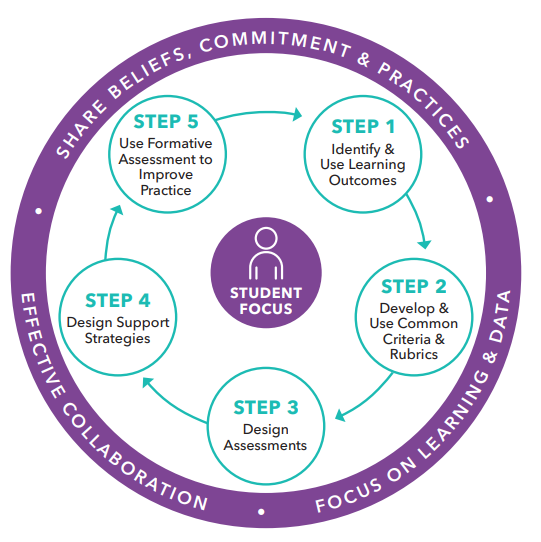
Pathway Community of Practice Overview
During the pathway design process the CoP works together to translate district-and school-level student learning outcomes into pathway outcomes. The CoP uses backwards planning to map these outcomes into benchmarks describing
what students must know and be able to do at each grade level of the pathway. This work helps CoP members decide how they will assess student progress in meeting the specified pathway student learning outcomes. They then
develop the curriculum and instruction that will guide students in attaining these outcomes.
Instructional Design and Revision Cycle
Excellence in pathway design and delivery depends upon the persistent pursuit of improvement. Data collection and review are an important part of this work and require preparation, time for analysis, and agreement on quality expectations.
Academic and career and technical education (CTE) teachers work with colleagues on their pathway team, and with district and industry partners, to create clear pathway, course, and project outcomes aligned with State academic content and CTE standards. These outcomes guide their pathway’s program of study and their assessment, curricular, and instructional planning.
Domain Resources 1-4:
- X
- X
- X
- X
Academic and CTE teachers collaborate with colleagues on their team, and with district and industry partners when appropriate, to select the outcomes-aligned criteria and language in common rubrics that they will use to judge the quality of student products and performance.
Domain Resources:
- X
- X
- X
Academic and CTE teachers collaborate with industry and other partners to design authentic performance assessment tasks for projects and coursesthrough which students will demonstrate their progress toward and defend their mastery of course, pathway, and district graduate outcomes, as measured on common rubrics.
Domain Resources:
- X
- X
- X
Academic and CTE teachers collaborate with industry and other partners to design integrated units of instruction that reflect the five behaviors of learning and teaching and through which students demonstrate proficiency on the performance assessment tasks as measured by the rubric.
Domain Resources:
- X
- X
- X
Pathway teachers design short-cycle formative assessments to be used during their units of instruction to (a) identify students who need additional time and support; (b) use patterns in student learning to discover strengths and weaknesses in curriculum and individual teaching; (c) measure individual and common progress toward pathway outcomes and key standards; and (d) provide feedback to students so they can revise and refine their work.
Domain Resources:
- X
- X
- X
)